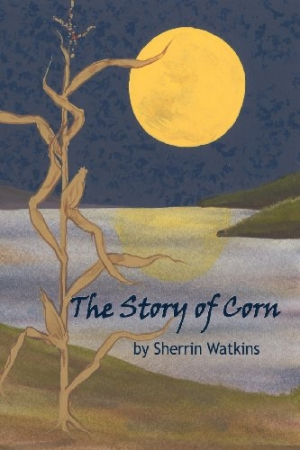The Story of Corn
Serious, humorous, and insightful, this historical novel chronicles a vanished way of life; it’s a must-read for adventure-seeking youth.
In Sherrin Watkins’ The Story of Corn, an unnamed fictional Shawnee and reformed alcoholic tells his coming of age story as a twelve-year-old just before the American Revolution. Using the stages of preparation, seeding, tending, and harvesting corn as the structure for the well-paced novel, Watkins adeptly blends historical facts with daily life and details the boy’s experiences in the mid-eighteenth century as he edges toward becoming a warrior.
Watkins is eminently qualified to author this book—she is a Cherokee Shawnee and has written other children’s books on the subject, one of which, Green Snake Ceremony, won her the Gamma State Author’s Award.
The Story of Corn begins with the elder Shawnee recalling how, as a twelve-year-old on the last night of the Spring Bread Dance, he told frightening ghost stories to younger children in the dark. They panicked, and, in the confusion, his brother, Warbler, and their nephew, Rabbit, were pushed into the Muskingum River, barely escaping with their lives. From there, the trio and the narrator’s Uncle Wildcat go on to other adventures and misadventures, some serious, some humorous, but all offering insight into a vanishing way of life and all written in clear, clean prose.
An episode about his sister’s “borrowed” and wrecked canoe leads to an extended description of how canoes are built. Discussions on the value of flint versus metal for hunting add further interest. And the details of the yearlong training to become a warrior are an eye-opener for today’s teenagers. On the spiritual side, Watkins’ hero refers to beliefs in “the Little People” and in the Milky Way, “where souls wait, on the smallest stars, to jump into babies when they are being born.”
Watkins also deals fairly and objectively but realistically with larger issues such as the loss of trust between Indian tribes and the government, the diseases white settlers imported, including alcoholism, and the torture of Captain Crawford as revenge for the slaughter of the Moravian Delaware Indian Christians. His death is graphic but revealing of how “a good man satisfied his murdered relatives by revenge.”
The front cover wraparound artwork of a cornfield under a full moon is a perfect fit for the theme and content of the book. However, some readers may be put off by the small type face of the text inside. Others may find the lack of a name for the hero to be disconcerting. A map of the Shawnee claimed territory would be a welcomed enhancement.
All in all, The Story of Corn is a must-read for understanding and appreciating the Shawnee way of life and the impact of white settlers upon it in the mid-1700s.
Reviewed by
Wayne Cunningham
Disclosure: This article is not an endorsement, but a review. The publisher of this book provided free copies of the book and paid a small fee to have their book reviewed by a professional reviewer. Foreword Reviews and Clarion Reviews make no guarantee that the publisher will receive a positive review. Foreword Magazine, Inc. is disclosing this in accordance with the Federal Trade Commission’s 16 CFR, Part 255.

